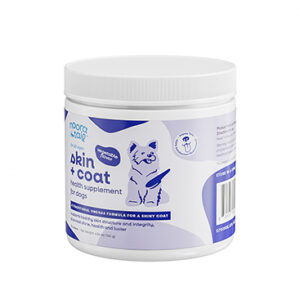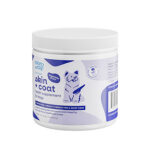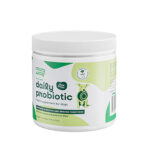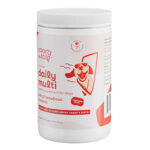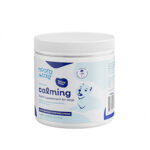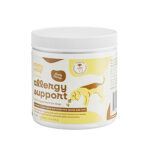Essential Oils for Dogs with Allergies

Allergies are a common problem for dogs, causing a wide range of symptoms from itchy skin and sneezing to vomiting and diarrhea. While traditional veterinary treatments can often alleviate these symptoms, some pet owners are looking for more natural alternatives. Essential oils are becoming increasingly popular as a natural way to treat dog allergies.
Understanding Allergies in Dogs
Allergies occur when the immune system overreacts to a foreign substance known as an allergen. In dogs, common allergens include pollens, dust mites, mold spores, and certain foods. When a dog is exposed to an allergen, the immune system releases histamines and other inflammatory chemicals, which cause the symptoms of allergy.
Benefits of Essential Oils for Dog Allergies
Certain essential oils have properties that can help reduce inflammation, relieve itching, and strengthen the immune system. These effects can help alleviate allergy symptoms in dogs. However, it’s important to note that not all essential oils are safe for dogs, and some can even be toxic. Therefore, it’s crucial to use only essential oils that have been specifically recommended for dogs and to always follow proper usage instructions.
Choose the Right Essential Oils
The most commonly recommended essential oils for dog allergies include:
- Lavender: Calming and anti-inflammatory
- Chamomile: Soothing and relaxing
- Frankincense: Anti-inflammatory and pain-relieving
- Copaiba: Anti-inflammatory and antioxidant
- Tea Tree Oil: Antibacterial and antifungal
How to Use Essential Oils
There are several ways to use essential oils for dog allergies:
- Diffusion: Adding a few drops of an essential oil to a diffuser can help disperse the oil into the air, where it can be inhaled by the dog.
- Topical application: Diluting an essential oil with a carrier oil, such as coconut oil, and applying it to the dog’s skin can help soothe itchy areas and reduce inflammation.
- Bath: Adding a few drops of an essential oil to the dog’s bathwater can help relax them and provide relief from allergy symptoms.
Safety Precautions
- Always dilute essential oils with a carrier oil before applying them to your dog’s skin.
- Avoid using essential oils that are toxic to dogs, such as eucalyptus, tea tree oil (undiluted), and cinnamon.
- Use essential oils sparingly and avoid prolonged use.
- Monitor your dog for any adverse reactions, such as skin irritation, breathing difficulties, or vomiting.
- If you have any concerns about using essential oils for your dog, consult with your veterinarian first.
Natural Remedies for Dog Allergies
In addition to essential oils, there are other natural remedies that may help alleviate dog allergies:
- Hypoallergenic diet: Identifying and eliminating food allergens can significantly reduce allergy symptoms.
- Allergy shots: These injections gradually expose the dog to increasing doses of the allergen to desensitize them.
- Herbal supplements: Certain herbs, such as quercetin and bromelain, have anti-inflammatory and immune-boosting properties.
- Regular grooming: Bathing and brushing the dog regularly can remove allergens from their fur.
Conclusion
While essential oils can be a natural and effective way to alleviate dog allergies, it’s important to use them safely and responsibly. Always consult with your veterinarian before using essential oils on your dog and follow proper usage instructions. By combining natural remedies with appropriate veterinary care, you can help your dog manage their allergies and live a more comfortable life.
Introduction

Introduction:
Allergies are a common ailment in dogs, just like in humans. They can cause a range of symptoms, from itchy skin and sneezing to difficulty breathing. While there are many conventional treatments for allergies, some pet owners are turning to essential oils as a natural alternative.
Understanding Essential Oils:
Essential oils are concentrated plant extracts that contain the plant’s therapeutic properties. They are typically extracted through steam distillation or cold pressing. Essential oils have been used for centuries in traditional medicine to treat a variety of health conditions.
How Essential Oils Work:
Essential oils work by interacting with the body’s receptors, which are located throughout the body, including the skin, respiratory system, and digestive tract. When applied, essential oils can trigger specific physiological responses, such as reducing inflammation, alleviating pain, or calming the nervous system.
Are Essential Oils Safe for Dogs?
While essential oils can be beneficial for dogs, it’s important to note that they can also be toxic if used improperly. Certain essential oils, such as tea tree oil, wintergreen, and eucalyptus, are highly toxic to dogs and should never be used.
Always dilute essential oils with a carrier oil, such as coconut oil or jojoba oil, before applying them to your dog’s skin. A general guideline is to dilute 1 drop of essential oil in 10 drops of carrier oil. Avoid applying essential oils directly to mucous membranes, such as the eyes, nose, or mouth.
Essential Oils for Dogs with Allergies:
Several essential oils have shown promise in reducing allergy symptoms in dogs. These include:
- Lavender: Lavender has calming and anti-inflammatory properties that can help soothe itchy skin and reduce anxiety associated with allergies.
- Chamomile: Chamomile is another calming essential oil that can help reduce inflammation and relieve stress.
- Eucalyptus: Eucalyptus essential oil has decongestant and expectorant properties that can help clear nasal passages and relieve congestion.
- Peppermint: Peppermint essential oil has cooling and anti-inflammatory properties that can help reduce skin irritation and itching.
- Helichrysum: Helichrysum essential oil has powerful anti-inflammatory and antihistamine properties that can help alleviate allergy symptoms.
How to Use Essential Oils for Dogs with Allergies:
There are several ways to use essential oils to treat allergies in dogs. These include:
- Diffusing: Diffusing essential oils into the air can help create a calming and therapeutic environment for your dog. Use a diffuser specifically designed for essential oils and follow the manufacturer’s instructions carefully.
- Topical application: Dilute essential oils with a carrier oil and apply them topically to your dog’s skin. Avoid applying essential oils directly to areas with open wounds or skin irritation.
- Inhalation: Allow your dog to inhale essential oils by placing a few drops on a cotton ball or bandana and letting them sniff it.
Caution and Precautions:
- Always consult with your veterinarian before using essential oils on your dog.
- Dilute essential oils properly with a carrier oil.
- Never apply essential oils directly to mucous membranes.
- Avoid using essential oils on puppies under 12 weeks of age.
- If your dog shows any signs of an adverse reaction to essential oils, stop using them immediately and consult with your veterinarian.
Conclusion:
Essential oils can be a safe and effective natural remedy for dogs with allergies when used properly. They can help reduce inflammation, soothe itching, and ease anxiety associated with allergies. By following the precautions outlined in this article, you can use essential oils to provide your furry friend with gentle relief from their allergy symptoms.
Types of Essential Oils for Dog Allergies

Allergies are a common issue for dogs, manifesting in symptoms such as itchy skin, sneezing, and runny eyes. Conventional treatments often rely on antihistamines or steroids, which can have potential side effects. Essential oils, derived from plants, offer a natural and effective alternative for managing dog allergies.
Understanding Essential Oils for Dogs
Essential oils are highly concentrated plant extracts that contain powerful therapeutic properties. They can be diffused into the air, applied topically, or added to baths to provide relief from various ailments. However, it’s crucial to use essential oils specifically formulated for dogs as some human-grade oils can be toxic to pets.
Types of Essential Oils for Dog Allergies
1. Lavender
Lavender oil is known for its calming and anti-inflammatory properties. It can help reduce itching, soothe irritated skin, and promote relaxation.
2. Frankincense
Frankincense oil has powerful anti-inflammatory and analgesic effects. It can help relieve joint pain and reduce swelling associated with allergic reactions.
3. Chamomile
Chamomile oil is a gentle and soothing oil that can calm inflammation, reduce anxiety, and aid in relaxation. It’s also known for its antihistamine properties, which can help alleviate allergy symptoms.
4. Eucalyptus
Eucalyptus oil is a decongestant and expectorant. It can help clear nasal passages, reduce sneezing, and provide relief from respiratory symptoms associated with allergies.
Using Essential Oils for Dog Allergies
Diffusing: Add a few drops of essential oil to a diffuser and let it disperse into the air. Diffusion can provide a calming and soothing environment for your dog, helping to reduce anxiety and inflammation.
Topical Application: Dilute 1-2 drops of essential oil in a carrier oil, such as coconut or jojoba oil. Apply the mixture topically to itchy or irritated areas. Always perform a patch test on a small area first to rule out any allergic reactions.
Baths: Add a few drops of essential oil to your dog’s bathwater. Allow your dog to soak for about 10 minutes, then rinse thoroughly. Bathing can help soothe irritated skin and provide relief from allergy symptoms.
Safety Considerations
- Never use essential oils undiluted on your dog.
- Avoid using essential oils that are toxic to dogs, such as tea tree oil or citrus oils.
- If your dog has a history of respiratory problems, consult with your veterinarian before using essential oils.
- Always supervise your dog when using essential oils.
- Keep essential oils out of the reach of pets. If ingested, they can be toxic.
Conclusion
Essential oils can be a safe and effective natural solution for managing dog allergies. By using the right oils and following proper safety precautions, you can provide your furry companion with relief from symptoms and improve their overall well-being. Remember to consult with your veterinarian before using essential oils to ensure proper usage and to rule out any underlying medical conditions.
How to Use Essential Oils for Dog Allergies

Allergies are a common issue for dogs, causing discomfort and irritation. While there are a variety of conventional treatments available, essential oils offer a natural and effective alternative to alleviate these symptoms.
Understanding Dog Allergies
Dog allergies are typically caused by allergens in the environment, such as pollen, dust mites, grass, or certain foods. When a dog comes into contact with an allergen, their immune system overreacts, releasing histamine and other inflammatory compounds. This can lead to a variety of symptoms, including:
- Itchy skin
- Redness and inflammation
- Sneezing and coughing
- Runny nose and eyes
- Gastrointestinal issues
Using Essential Oils for Dog Allergies
Essential oils are highly concentrated extracts from plants, containing active compounds that have medicinal properties. Certain essential oils have anti-inflammatory, antihistamine, and antimicrobial effects, making them well-suited for treating dog allergies.
1. Diffusing
Diffusing essential oils into the air can help distribute their therapeutic benefits throughout your home. This is a simple and effective way to alleviate allergy symptoms in dogs.
- Add 5-10 drops of an essential oil blend (see below) to a diffuser.
- Turn on the diffuser and let it run for 30-60 minutes, or as needed.
- Repeat as necessary throughout the day.
2. Applying Topically
Essential oils can also be applied topically to soothe itchy and irritated skin. However, it is crucial to dilute essential oils with a carrier oil before applying them to your dog.
- Mix 1 drop of an essential oil blend (see below) with 1 teaspoon of a carrier oil, such as coconut oil or olive oil.
- Gently massage the mixture into the affected areas, avoiding the eyes and mouth.
- Use caution and monitor your dog’s reaction.
3. Bathing with Essential Oils
Adding essential oils to your dog’s bath can provide a relaxing and therapeutic experience.
- Add 5-10 drops of an essential oil blend (see below) to a warm bath.
- Allow your dog to soak in the bath for 10-15 minutes.
- Rinse your dog thoroughly and towel dry.
Recommended Essential Oils for Dog Allergies
- Lavender: Anti-inflammatory, antihistamine, calming
- Chamomile: Anti-inflammatory, soothing, antispasmodic
- Frankincense: Anti-inflammatory, analgesic, antimicrobial
- Eucalyptus: Decongestant, antibacterial
- Tea Tree: Antiseptic, antifungal, anti-inflammatory
Essential Oil Blend for Dog Allergies
- 2 drops Lavender
- 2 drops Chamomile
- 1 drop Frankincense
Precautions
- Always dilute essential oils with a carrier oil before applying them to your dog.
- Do not apply essential oils to your dog’s face or near their eyes or mouth.
- Do not use essential oils on pregnant or nursing dogs.
- Some essential oils can be toxic to dogs, such as tea tree oil and oregano oil. Always consult a veterinarian or a certified aromatherapist before using essential oils on dogs.
Conclusion
Essential oils can be a safe and effective way to alleviate allergy symptoms in dogs. By diffusing, applying topically, or bathing with essential oils, you can help reduce inflammation, soothe irritated skin, and improve your dog’s overall well-being. However, it is important to use essential oils with caution and always consult a veterinarian or a qualified aromatherapist before using them on your pet.
Benefits of Essential Oils for Dog Allergies

Allergies in dogs, akin to those in humans, can manifest as a myriad of uncomfortable symptoms that can disrupt their daily lives. These symptoms, ranging from itchy skin and rashes to respiratory issues, can significantly affect their well-being. Fortunately, essential oils, with their potent therapeutic properties, offer a natural and effective solution for alleviating these allergic reactions in dogs.
Essential Oils: Nature’s Remedy for Dog Allergies
Essential oils are concentrated plant extracts that have been widely used in aromatherapy for their medicinal benefits. They possess a range of properties that can address the specific challenges posed by dog allergies, providing relief and supporting overall skin health.
Benefits of Essential Oils for Dog Allergies
1. Reduced Inflammation
Inflammation is a common symptom of allergies, and it can contribute to the discomfort and pain associated with allergic reactions. Essential oils such as lavender, chamomile, and frankincense possess powerful anti-inflammatory properties. These oils can help reduce swelling, redness, and itching, providing relief for affected areas.
2. Anti-itching Properties
Itching is a hallmark symptom of allergies, and it can be relentless and irritating for dogs. Essential oils like peppermint, tea tree, and eucalyptus contain analgesic and antipruritic properties. These oils can soothe the skin, reducing inflammation and providing relief from incessant itching.
3. Improved Skin Health
Allergies can take a toll on the skin of dogs, causing dryness, irritation, and even infections. Essential oils such as rosemary, juniper, and sandalwood have antibacterial, antifungal, and antiseptic properties. These oils can help maintain healthy skin, preventing infections and promoting healing.
Choosing the Right Essential Oils
When selecting essential oils for dogs with allergies, it’s essential to choose oils that are safe and effective for canine use. Some oils, such as tea tree oil, can be toxic to dogs in high concentrations, so it’s crucial to dilute them appropriately.
How to Use Essential Oils for Dogs with Allergies
There are several ways to incorporate essential oils into your dog’s allergy management regimen:
- Diffusion: Add a few drops of essential oil to a diffuser and disperse it in a well-ventilated area where your dog can inhale the therapeutic vapors.
- Topical Application: Dilute essential oils in a carrier oil, such as coconut or jojoba oil, and apply it directly to affected areas. Avoid applying undiluted oils directly to your dog’s skin.
- Shampoo or Conditioner: Add a few drops of essential oil to your dog’s shampoo or conditioner to create a soothing and anti-inflammatory bath time experience.
Caution and Considerations
While essential oils can be beneficial for dogs with allergies, it’s important to use them responsibly.
- Avoid using essential oils on dogs that are pregnant, nursing, or have skin conditions.
- Always dilute essential oils in a carrier oil before topical application.
- Monitor your dog closely for any adverse reactions, and discontinue use if any occur.
- Consult with your veterinarian before using essential oils for dogs with allergies.
Conclusion
Essential oils offer a natural and effective way to manage dog allergies. Their anti-inflammatory, anti-itching, and skin-healing properties can provide significant relief and support the overall well-being of dogs suffering from allergic reactions. When used responsibly and in consultation with a veterinarian, essential oils can enhance your dog’s quality of life and alleviate the discomfort associated with allergies.
Precautions When Using Essential Oils for Dogs
As a dog owner, you want nothing but the best for your furry companion. When your dog suffers from allergies, essential oils can provide a natural and effective solution. However, it’s crucial to use these powerful oils with caution to ensure your dog’s well-being. Here are some essential precautions to observe when using essential oils for dogs with allergies:
1. Diluting Essential Oils
Essential oils are highly concentrated and can be harmful to dogs if used undiluted. Always dilute essential oils in a suitable carrier oil, such as coconut oil, jojoba oil, or olive oil. A general rule is to use 1-2 drops of essential oil per ounce of carrier oil. For small dogs, use even less.
2. Avoiding Contact with Eyes and Mouth
Essential oils can be irritating to your dog’s eyes and mouth. Avoid applying essential oils directly to these areas. If it accidentally comes into contact, wipe it away immediately with a damp cloth.
3. Watching for Signs of Allergies
Some dogs may be allergic to certain essential oils. Monitor your dog for any signs of an allergic reaction, such as redness, swelling, itching, or breathing difficulties. If you notice any of these symptoms, discontinue use immediately and consult your veterinarian.
4. Choosing High-Quality Oils
The quality of the essential oil you use is crucial. Look for 100% pure, therapeutic-grade essential oils from reputable sources. Avoid using synthetic fragrances or oils diluted with other substances.
5. Diffusing Cautiously
Diffusing essential oils can be an effective way to provide relief for airborne allergens. However, it’s essential to use a diffuser that is specifically designed for pets. Avoid using diffusers that generate heat, as this can alter the chemical composition of the oils and make them harmful.
6. Limiting Exposure Time
When using essential oils for dogs with allergies, it’s important to limit their exposure time. Diffuse for short periods (15-30 minutes) and provide plenty of fresh air afterwards.
Additional Precautions:
- Always consult your veterinarian before using essential oils on your dog, especially if your dog has any underlying health conditions.
- Avoid using essential oils on pregnant or nursing dogs.
- Store essential oils in a cool, dark place out of reach of your dog.
- Never use essential oils as a substitute for veterinary care.
Conclusion
Essential oils can be a beneficial tool for managing allergies in dogs, but it’s essential to use them with caution. By following these precautions, you can minimize any potential risks and ensure that your dog enjoys the full benefits of essential oils while staying safe and healthy. Remember, it’s always best to consult with your veterinarian for personalized advice and guidance on using essential oils for your dog’s specific needs.
Other Considerations
Allergies can be a common and uncomfortable issue for dogs, causing a range of symptoms such as itchy skin, sneezing, and watery eyes. While traditional medications can provide relief, some pet owners are turning to natural remedies like essential oils. However, using essential oils for dogs with allergies requires careful consideration to ensure their safety and effectiveness.
Understanding Essential Oils
Essential oils are concentrated plant extracts that possess potent therapeutic properties. Many essential oils have anti-inflammatory, antibacterial, and antihistamine qualities, making them potential remedies for allergies in dogs.
Choosing the Right Essential Oils
Not all essential oils are safe for dogs. Some, like tea tree oil, can be toxic if ingested. Safe and effective essential oils for dogs with allergies include:
- Lavender
- Chamomile
- Frankincense
- Peppermint
- Copaiba
Other Essential Considerations
When using essential oils for dogs with allergies, several factors must be taken into account:
a. Dosage:
The dosage of essential oils depends on the size and weight of the dog. A general guideline is to use 1-2 drops diluted in a carrier oil (such as coconut oil or olive oil) for small dogs, 3-4 drops for medium dogs, and 5-6 drops for large dogs.
b. Frequency of Use:
Essential oils should not be used on dogs every day. For acute allergic reactions, apply diluted oil topically 2-3 times per day. For chronic allergies, use once or twice daily.
c. Consulting with a Veterinarian:
Before using essential oils on your dog, it is crucial to consult with a veterinarian. They can provide personalized guidance on dosage, frequency of use, and any potential interactions with medications.
Application Methods
There are several ways to apply essential oils to dogs:
- Topically: Dilute essential oils in a carrier oil and apply a small amount to the affected area.
- Inhalation: Add a few drops to a diffuser and let the dog inhale the vapor.
- Bath: Mix a few drops with a cup of Epsom salts and add to the dog’s bathwater.
Precautions
- Never apply undiluted essential oils directly to your dog’s skin.
- Avoid using essential oils around puppies under 6 months old.
- If your dog shows any signs of irritation, discontinue use immediately.
- Keep essential oils out of reach of pets.
Conclusion
Essential oils can be a natural and effective way to manage allergies in dogs. However, it is essential to use them safely and responsibly. By following the guidelines outlined in this article, you can harness the benefits of essential oils while ensuring your dog’s well-being. Always consult with your veterinarian before using essential oils on your pet to ensure their safety and suitability.
Essential Oil Blends for Dog Allergies
Allergies are a common problem for dogs, and they can be a source of great discomfort for your furry friend. Fortunately, there are a number of natural remedies that can help to relieve allergy symptoms in dogs, including essential oils.
Essential oils are concentrated plant oils that have been used for centuries to treat a variety of health conditions. They are thought to work by interacting with the body’s immune system and nervous system.
Some essential oils have been shown to be particularly effective at reducing allergy symptoms in dogs. These oils include:
- Lavender has calming and anti-inflammatory properties that can help to relieve itching and redness.
- Frankincense is a powerful anti-inflammatory that can help to reduce swelling and pain.
- Chamomile is a gentle antihistamine that can help to reduce sneezing and runny nose.
There are a number of different ways to use essential oils to relieve allergy symptoms in dogs. You can:
- Apply a few drops of oil to your dog’s skin, diluted in a carrier oil such as coconut oil or jojoba oil.
- Add a few drops of oil to your dog’s bathwater.
- Diffuse essential oils in your home, using a diffuser or humidifier.
It is important to note that not all essential oils are safe for dogs. Some oils, such as tea tree oil and oregano oil, can be toxic to dogs. It is always best to consult with a veterinarian before using essential oils on your dog.
Here are a few essential oil blends that you can try for dogs with allergies:
Blend A:
- 2 drops lavender oil
- 2 drops frankincense oil
Blend B:
- 2 drops chamomile oil
- 2 drops eucalyptus oil
Blend C:
- 2 drops lavender oil
- 2 drops frankincense oil
- 2 drops chamomile oil
To use any of these blends, simply mix the oils together in a small bowl. You can then apply a few drops of the blend to your dog’s skin, diluted in a carrier oil. You can also add a few drops of the blend to your dog’s bathwater or diffuse the blend in your home.
It is important to start with a low dose of essential oils and gradually increase the dose as needed. You should also monitor your dog closely for any signs of adverse reactions. If your dog experiences any irritation or discomfort, discontinue use of the essential oils.
Essential oils can be a safe and effective way to relieve allergy symptoms in dogs. However, it is important to use them with caution and to consult with a veterinarian before using them on your dog.
Choosing the Right Essential Oil for Your Dog
Introduction
Allergies are a common problem among dogs, causing symptoms such as itchy skin, sneezing, and runny eyes. While conventional medications can provide relief, pet owners are increasingly turning to natural remedies like essential oils for their soothing and therapeutic properties. However, choosing the right essential oil for your dog can be a daunting task. This comprehensive guide will equip you with the knowledge to make informed decisions and safely incorporate essential oils into your dog’s allergy management routine.
Consider Your Dog’s Age, Size, and Health
Before introducing essential oils to your dog, it’s essential to consider their age, size, and health status. Puppies and senior dogs may have more sensitive skin, so it’s important to use diluted oils and avoid strong scents. Larger dogs will require more oil than smaller breeds. Dogs with underlying health conditions should be monitored closely while using essential oils. Always consult with a veterinarian before using any essential oils on a dog with health issues.
Research Different Essential Oils and Their Benefits
There are numerous essential oils that can help relieve allergy symptoms in dogs. Some of the most commonly used include:
- Lavender oil: Calming and relaxing, can help reduce itching and inflammation
- Tea tree oil: Antibacterial and antifungal, can help soothe skin irritations
- Chamomile oil: Anti-inflammatory and antispasmodic, can help reduce sneezing and coughing
- Eucalyptus oil: Decongestant and expectorant, can help clear nasal passages
- Peppermint oil: Cooling and energizing, can help boost immunity and reduce itching
Consult with a Veterinarian or Animal Aromatherapist
While essential oils can be a safe and effective way to manage allergies in dogs, it’s crucial to seek professional advice before use. A veterinarian or animal aromatherapist can help you determine the appropriate oils, dosage, and application method for your dog’s specific needs. They can also provide guidance on contraindications and potential interactions with other medications your dog may be taking.
Safe Application Methods
Essential oils should never be applied undiluted directly to your dog’s skin. The preferred methods of application include:
- Diffusion: Using a diffuser to disperse the essential oils into the air can help create a calming and soothing environment for your dog.
- Topical application: Diluting essential oils with a carrier oil, such as coconut or jojoba oil, and applying it to affected areas can provide localized relief. Always test the diluted oil on a small patch of skin first to ensure there is no adverse reaction.
- Bath soak: Adding a few drops of essential oil to your dog’s bathwater can be a relaxing and therapeutic experience. Be sure to use a small amount of oil and rinse your dog thoroughly after the bath.
Dosage Guidelines
The dosage of essential oils for dogs will vary depending on the oil used and the size of the dog. A general rule of thumb is to dilute 1-2 drops of essential oil in 10 ml of carrier oil. For larger dogs, you may increase the dosage slightly, while for puppies or small dogs, you should reduce it. Always start with a small amount and gradually increase as needed, monitoring your dog’s response closely.
Conclusion
Essential oils can be a valuable addition to your dog’s allergy management routine. By choosing the right oil, diluting it properly, and consulting with a veterinarian or animal aromatherapist, you can safely and effectively alleviate your furry friend’s allergy symptoms. Remember to use essential oils responsibly and observe your dog’s response carefully. With the right approach, essential oils can provide your dog with much-needed relief and enhance their overall well-being.
Additional Tips
Allergies are a common problem among dogs, causing a wide range of uncomfortable symptoms. While there is no cure, essential oils offer a natural and effective way to provide relief. This comprehensive guide will explore the benefits of using essential oils for dogs with allergies, as well as additional tips for managing the condition.
Benefits of Essential Oils for Dogs with Allergies
Essential oils are concentrated plant extracts that contain powerful therapeutic compounds. These compounds have been shown to:
- Reduce inflammation: Essential oils like lavender, chamomile, and frankincense have anti-inflammatory properties that can help soothe irritated skin and airways.
- Boost the immune system: Oils like tea tree oil and eucalyptus oil contain antimicrobial and antiviral properties that can strengthen the immune system and reduce the risk of infections.
- Promote relaxation: Oils like lavender and valerian root can help calm anxious dogs and reduce stress, which can exacerbate allergy symptoms.
- Improve respiratory function: Peppermint oil and eucalyptus oil can help open up airways and ease breathing.
How to Use Essential Oils for Dogs with Allergies
- Dilute the oil: Essential oils are highly concentrated and can be toxic to dogs if used undiluted. Always dilute the oil in a carrier oil, such as coconut oil or jojoba oil, before applying it to your dog. A ratio of 1 drop of essential oil to 10 drops of carrier oil is a good starting point.
- Topical application: Apply the diluted oil to the affected areas of your dog’s skin. You can also add it to your dog’s shampoo or conditioner for a soothing effect.
- Diffusion: Diffusing essential oils into the air can help improve respiratory function and create a calming atmosphere. Use a diffuser specifically designed for dogs and follow the manufacturer’s instructions.
- Oral administration: Some essential oils, such as chamomile and valerian root, can be administered orally in small doses. Consult with your veterinarian before giving your dog any essential oils orally.
Additional Tips for Managing Dog Allergies
In addition to using essential oils, there are several other strategies that can help manage your dog’s allergies:
- Using a humidifier: A humidifier can add moisture to the air, which can help soothe dry, irritated skin and airways.
- Providing a hypoallergenic diet: A diet that excludes common allergens, such as grains, dairy, and beef, can help reduce inflammation and improve skin health.
- Avoiding environmental triggers: Identify and avoid the environmental triggers that cause your dog’s allergies, such as pollen, dust, and mold. Regularly clean your dog’s bedding and vacuum your home to remove potential allergens.
Conclusion
Essential oils offer a natural and effective way to provide relief for dogs with allergies. By following proper dilution and application guidelines, you can safely use essential oils to soothe inflammation, boost immunity, promote relaxation, and improve respiratory function. Remember, it is always essential to consult with your veterinarian before using essential oils on your dog and to combine essential oil therapy with other management strategies to effectively control your dog’s allergies.








